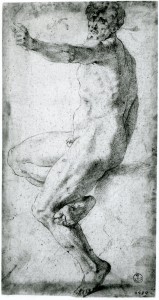c. 1523
Florence, Uffizi, no. 6489F.
Red chalk, 39.6 x 21.6; wm., a balance, similar to Briquet 2511 and 2516, etc. Inscribed on the mat: Clemente (L.M.) [Luisa Marcucci].
LITERATURE:
Berenson, 1903, no. 2420, as Rosso.
Kusenberg, 1931, 135, 140, no. 26, as Rosso.
Berenson, 1938, no. 2420, as Rosso.
Barocchi, 1950, 165, 196, Fig. 163, as Rosso, around 1523.
Carroll, 1961, 448, Fig. 8, 449, n. 12, 450, as Rosso.
Berenson, 1961, no. 2420, as Rosso.
Carroll, 1964 (1976), I, Bk. I, 97-99, Bk., II, 222-223, D.12, II, Bk. III, Fig. 29, as Rosso, 1523.
Carroll, 1987, 20, 64-65, no. 5, with Fig., as Rosso, c. 1523.
Franklin, 1988, 324, Fig. 85, as Rosso.
Miller, 1992, 112.
Franklin, 1994, 122, 123, Pl. 88, as usually dated around the time of the Sposalizio.
The face of this male nude closely resembles that of the saint with a staff behind St. Bernard in the Dei Altarpiece (Fig.P.12a) and that of the hooded monk and of the priest in the Marriage of the Virgin (Fig.P.13a), not only physiognomically but also in the manner in which they are described with juxtaposed small patches of light and shade. His curly hair is quite like that of the man in back of St. Joseph in the latter altarpiece. The pointing hand bears some resemblance to that of St. Peter in the Dei Altarpiece, and the tautly held and interlocked legs and feet recall the posture of Christ in the Dead Christ in Boston (Fig.P.18a).
Graphically, the drawing is almost identical to the study for the figure of St. Sebastian in the Dei Altarpiece (Fig.D.7), to the “Virtù” Vanquishing Fortune (Fig.D.6a), and to the Standing Nude Woman (Fig.D.5), all datable between 1520 and 1522. Compared to Rosso’s paintings and drawings of the early 1520s, the Seated Male Nude is certainly identifiable as his and from around the same time.
However, the intensely brilliant light in the drawing is most similar to that in the Marriage of the Virgin of 1523. Almost exactly as in that painting the light in the drawing enters from the side, boldly strikes the front of the figure, rakes across the irregular surface of the side of the seated nude creating a faceted network of varied patches of shadow, and then casts the back of the figure into an even, but still slightly luminous, shadow. The light in the Dei Altarpiece and in the study for the figure of St. Sebastian in it is described in somewhat the same way, but not with the same brilliance and subtle variations of light and shade that appear in the altarpiece of 1523. Consequently, the Seated Male Nude was most probably done about the same time as that painting. The pointing gesture of the figure suggests that it was designed for a narrative composition. It is just possible that the drawing was made for an early version of the Marriage of the Virgin, although perhaps for a figure that would have been clothed in the picture. It could have been for one of the suitors, or for one of the background figures, or even for the Dominican monk. However, this suggestion is somewhat undermined by the opposite direction of the light in the drawing.
Marcucci’s note on the mat of the drawing that it is by Clemente Bandinelli is not supported by a close comparison with those drawings kept under his name at the Uffizi,1 nor with his sculpture.2 Nor can her suggestion stand in the face of the visual evidence that supports the traditional attribution of this drawing to Rosso.
1 Marcucci’s published attributions (1953, 87, n. 22) of several drawings to Clemente, all once given to Rosso, are unconvincing, especially as one of them, Uffizi 6497F (D.12) is so certainly by Rosso.
See COPY, Vienna, Albertina, Sc. Rom. 4865, Nude male walking to the right with left arm raised, and, at the left, an armless nude seen to just above the knees, under P.15, Rebecca and Eliezer, as possibly a copy of a lost drawing by Rosso for the figure leading a camel (Fig.P.15Copy, Vienna).

